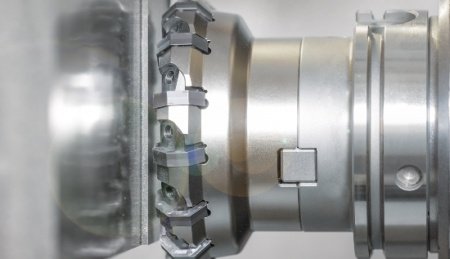
Milling Cast and Steel Parts More Cost-Effectively
Milling Cast and Steel Parts More Cost-Effectively
Dr. Wolfgang Baumann of Mapal explains the benefits of their latest radial insert milling range.

Whether they’re producing turbochargers, steering knuckles, or cylinder blocks, customers can mill their cast and steel parts considerably more cost-effectively with Mapal’s radial insert milling range than with the previously available solutions. Since the product launch in 2018, there have been many measurable successes resulting from the use of the tools in the series.
Mapal first showcased a product range for milling with compressed radial indexable inserts at the AMB exhibition in Stuttgart in 2018. “This move was the natural next step towards our aim of being a comprehensive service provider for our customers,” explains Dr. Wolfgang Baumann, who is responsible for the product range of tools with ISO elements at MAPAL. “But our aim isn’t just to provide the customer with all their machining needs in terms of tools and chucks—we also want to offer them added value through our solutions.”
According to Baumann, their focus before this milling range was mainly on supporting customers with specific application needs, such as providing support for high levels of stock removal or unstable conditions. This machining was mostly carried out using ground tangential indexable inserts.
“We’re obviously not the first company to offer a radial milling range. We’ve simply plugged a gap in our portfolio,” explains Baumann. “Through our work with special applications, we’ve accumulated extensive in-depth knowledge that has been incorporated into the development of our compressed radial blades. They, therefore, offer considerable added value and, in particular, economic benefits for users. The success stories that we’ve gathered over the past year prove that our meticulous work is paying off for our customers today.”
In many applications, the cost per part (CPP) was considerably reduced. “In many cases, other tools were superseded once we had analysed the application and selected the optimal tool,” Baumann explains. “For some applications, our tools now machine significantly more parts until the blades have to be replaced. And in some other machining operations, the same machining times per part can be achieved with fewer blades. However, there are other cases where we can achieve considerably higher cutting data with more blades. We sometimes rely on indexable inserts with more cutting edges, thanks to which each individual indexable insert can be used for considerably longer.”
As an example, three machining operations on customer parts demonstrate the added value that the radial milling range offers:
1.Turbocharger machining: Face milling of the hot side made of stainless steel
Mapal’s face milling cutter with nine blades replaces the previously available face milling cutter with seven blades.

With the new solution, 50 percent more parts are milled in total; the cycle time is considerably reduced; and the costs per part are 44 percent lower than previously.
2. Steering knuckle machining: Shoulder milling/roughing of various connection points on a steering knuckle made of cast iron with spheroidal graphite—stock removal of between 2.5 and 4.5 mm.
Mapal’s shoulder milling cutter with six blades replaces the previously available shoulder milling cutter with seven blades. Despite its negative clearance angle, it achieves the same tool life as the previously used solution with positively aligned indexable inserts.

Although the new milling cutter machines have exactly the same number of parts as the previous one, the costs per part are reduced by more than half—by 58 percent!
3. Cylinder block: Shoulder milling/roughing of various surfaces on cylinder blocks made of cast iron with lamellar graphite—stock removal of between 2 and 4 mm.
Mapal’s eight-edged shoulder milling cutter replaces a shoulder milling cutter that also has eight edges.

The tool life of the new milling cutter is considerably longer than that of its predecessors under identical operating conditions—even with its negatively aligned indexable insert. And on top of that, the cost per part is also reduced by 58 percent.
For other exclusive articles, visit www.equipment-news.com.
Check these articles out:
The Next Stage In The Evolution Of ISO Turning
Reliable, Cost Effective Serial Production Of Turbochargers
Seco 335.18 And 335.19 Cutters Enable Smooth, Problem-Free Disc Milling
Walter Expands Perform Product Range With New Milling Cutters With Corner Radius
Significantly Better Surface Finishes Thanks To Vibration Damping
Tungaloy Enables Efficient Heavy-Duty Roughing of Difficult Materials
Walter Tools Releases White Paper on Dynamic Milling
WANT MORE INSIDER NEWS? SUBSCRIBE TO OUR DIGITAL MAGAZINE NOW!
FOLLOW US ON: LinkedIn, Facebook, Twitter
